Textile Conservation in The Kingdom of Bhutan
By Julia M. Brennan
I never imagined that textile conservation would take me to the farthest reaches of the world, to the mountainous kingdom of Bhutan. But for this winter, thanks to a project funded by the non-profit organization, The Friends of Bhutan’s Culture, a dream came true. My grant to teach preventative conservation and textile conservation for six weeks at Bhutan’s Textile Museum was the first of its kind in Bhutan. It has launched the first generation of Bhutan’s conservation technicians, and inspired that country’s young professionals to pursue the important task of preserving their cultural property.
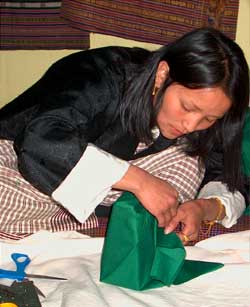 My base was the national Textile Museum in the capital city of Thimphu. Established in 2001, the museum houses about 800 textiles, representative of the country’s rich and complex hand weaving traditions. The museum’s two floors of gallery displays, two storage rooms, work room and wonderful gift shop are staffed by six employees and four resident hand weavers. It is a gem of a museum in a country where appreciation of textiles is evident everywhere–in the colorful daily dress, temple hangings and home ornamentation. In 2003, a gift of over 100 exceptional Bhutanese textiles augmented the museum holdings. One objective of our project was to use this newly acquired collection to teach the fundamentals of collections care and textile conservation. My base was the national Textile Museum in the capital city of Thimphu. Established in 2001, the museum houses about 800 textiles, representative of the country’s rich and complex hand weaving traditions. The museum’s two floors of gallery displays, two storage rooms, work room and wonderful gift shop are staffed by six employees and four resident hand weavers. It is a gem of a museum in a country where appreciation of textiles is evident everywhere–in the colorful daily dress, temple hangings and home ornamentation. In 2003, a gift of over 100 exceptional Bhutanese textiles augmented the museum holdings. One objective of our project was to use this newly acquired collection to teach the fundamentals of collections care and textile conservation.
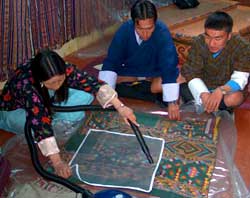 A team of six, we rapidly established a daily rhythm that exemplified dedicated collections care. We examined each textile and compiled a computer-based catalogue record. Textiles were then measured, tagged, condition reported, and prepared for freezing for pest management. A major aspect of our daily work was the systematic re-organization of storage and identification of future storage needs. We upgraded the storage rooms, in-stalling new roller racks and re-housing textiles. A team of six, we rapidly established a daily rhythm that exemplified dedicated collections care. We examined each textile and compiled a computer-based catalogue record. Textiles were then measured, tagged, condition reported, and prepared for freezing for pest management. A major aspect of our daily work was the systematic re-organization of storage and identification of future storage needs. We upgraded the storage rooms, in-stalling new roller racks and re-housing textiles.
Several of the books provided by the grant included textile terminology and structure. Because daily training emphasized accurate report writing, these were valuable references. Pest management and environmental monitoring, critical to maintaining textiles in Bhutan’s humid climate, were approached theoretically, then applied, using tools such as hygrothermographs, pest traps, and humidity and light fading indicators that I brought. Many other conservation materials supplied by the grant–fine threads, stabilization fabrics, tagging tape, and work tools–are not available locally. Having them on site enabled us to begin treatment immediately. The conservation resources and books provided under the grant established the beginning of a valuable library at the Textile Museum.
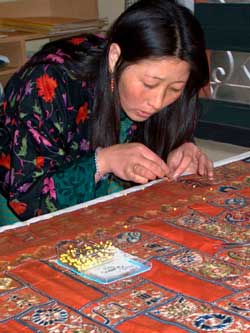 The project included a Textile Conservation Workshop held at the Textile Museum in Thimphu and the National Museum in Paro. This afforded a diversity of collections and challenges, and a collaboration of staffs. Ten to eighteen attendees with varying professional backgrounds participated in a program whose dual emphasis was preventative conservation and object treatment. Both components approached the collections as living laboratories. Exhibition displays were re-designed, storage facilities upgraded, and treatments such as wet-cleaning, stain removal, and stitch repairs were conducted. I observed important growth and significant skill acquisition during the Workshop. Attendees gained a fundamental understanding that each employee in a museum plays a vital role in the conservation and maintenance of the collections. The project included a Textile Conservation Workshop held at the Textile Museum in Thimphu and the National Museum in Paro. This afforded a diversity of collections and challenges, and a collaboration of staffs. Ten to eighteen attendees with varying professional backgrounds participated in a program whose dual emphasis was preventative conservation and object treatment. Both components approached the collections as living laboratories. Exhibition displays were re-designed, storage facilities upgraded, and treatments such as wet-cleaning, stain removal, and stitch repairs were conducted. I observed important growth and significant skill acquisition during the Workshop. Attendees gained a fundamental understanding that each employee in a museum plays a vital role in the conservation and maintenance of the collections.
The project concluded with the conservation of some of Bhutan’s most revered, sacred textile “relics.” These artifacts were brought from their monastic homes to the Textile Museum for a once-in-a-lifetime treatment. One piece, a silk brocade monk’s choegho or shawl, elaborately embroidered with mantras and the Eight Auspicious Symbols, is one of Bhutan’s most holy treasures. Once a year, the choegho is presented publicly, and pilgrims come from hundreds of miles to have an audience with this textile to receive the highest merits possible. Daily spiritual cleansing of the Textile Museum work-space preceded conservation work on the 16th-century shawl, and blessings were taken regularly.
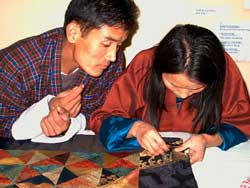 Museum staff demonstrated their newly acquired knowledge while working on the choegho. Our treatment approach involved the application of overlays to the split and damaged areas, as well as supports and selective hand stitching–fine and complex work. I was deeply gratified by the proficiency of their hand skills and their sensitivity to the artifact. Museum staff demonstrated their newly acquired knowledge while working on the choegho. Our treatment approach involved the application of overlays to the split and damaged areas, as well as supports and selective hand stitching–fine and complex work. I was deeply gratified by the proficiency of their hand skills and their sensitivity to the artifact.
The rare honor of working on such a sacred object was a grand finale for our team at the Museum. It raised our technical level and deepened our dedication to conservation work, and opened a window into the potential of future projects.
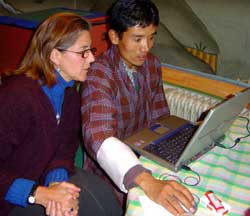 This project has seeded conservation education in Bhutan, a country where cultural preservation is at the heart of their commitment to development. Little did I know how receptive the staff would be to this opportunity to learn and absorb and carry on. Their dedication was a huge reward for me, confirming that outreach and the gift of knowledge does make a difference. Upon returning home, I have received letters from my colleagues describing their ongoing work and completion of certain projects–testament to the success of our training. I am certain that this is the start of conservation education in a unique country where cultural preservation is at the heart of their commitment to development, and aptly expressed in Bhutan’s national creed, “Gross National Happiness.” This project has seeded conservation education in Bhutan, a country where cultural preservation is at the heart of their commitment to development. Little did I know how receptive the staff would be to this opportunity to learn and absorb and carry on. Their dedication was a huge reward for me, confirming that outreach and the gift of knowledge does make a difference. Upon returning home, I have received letters from my colleagues describing their ongoing work and completion of certain projects–testament to the success of our training. I am certain that this is the start of conservation education in a unique country where cultural preservation is at the heart of their commitment to development, and aptly expressed in Bhutan’s national creed, “Gross National Happiness.”
Julia Brennan
Textile Conservation Services
[email protected] |
 |